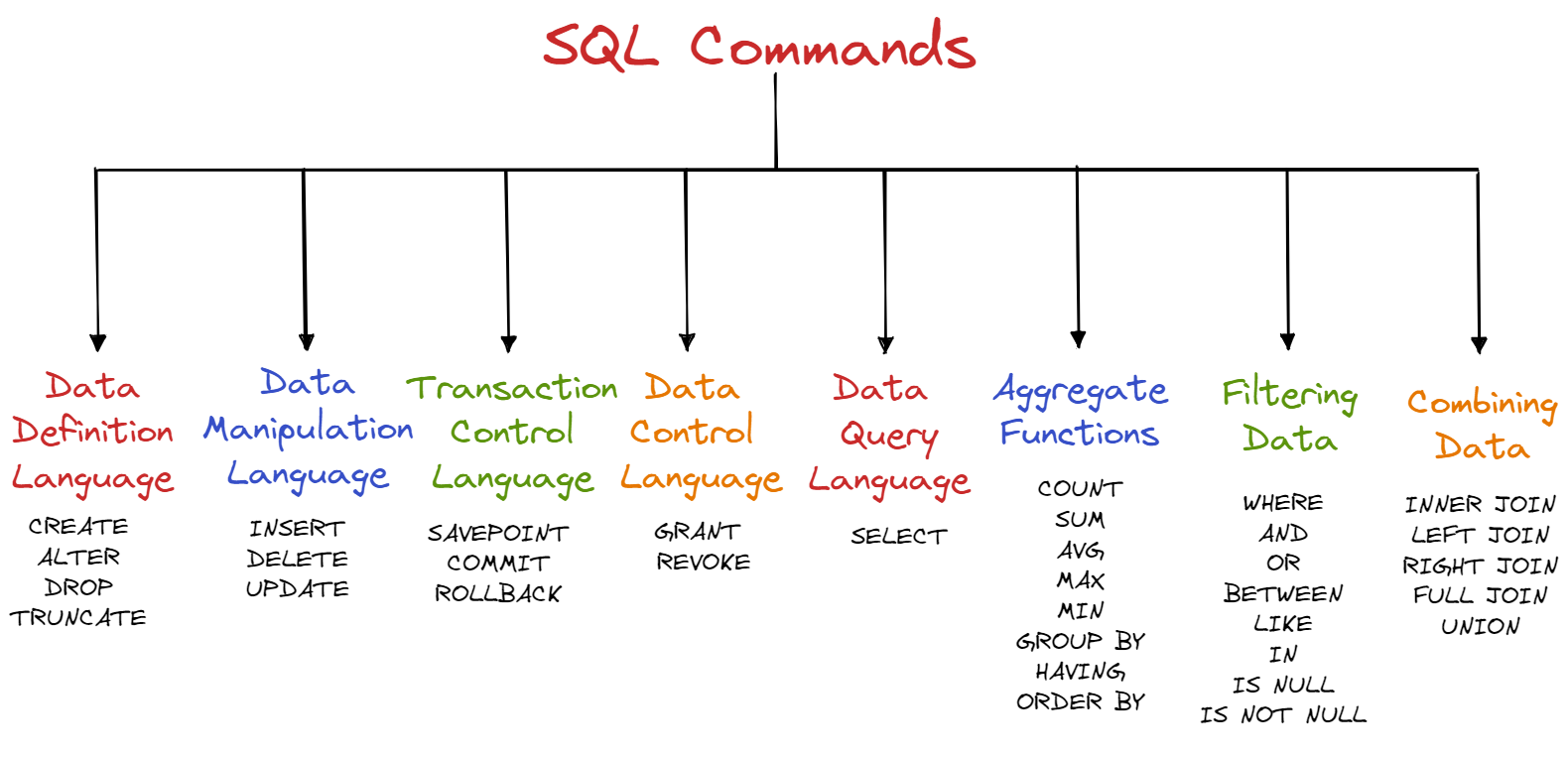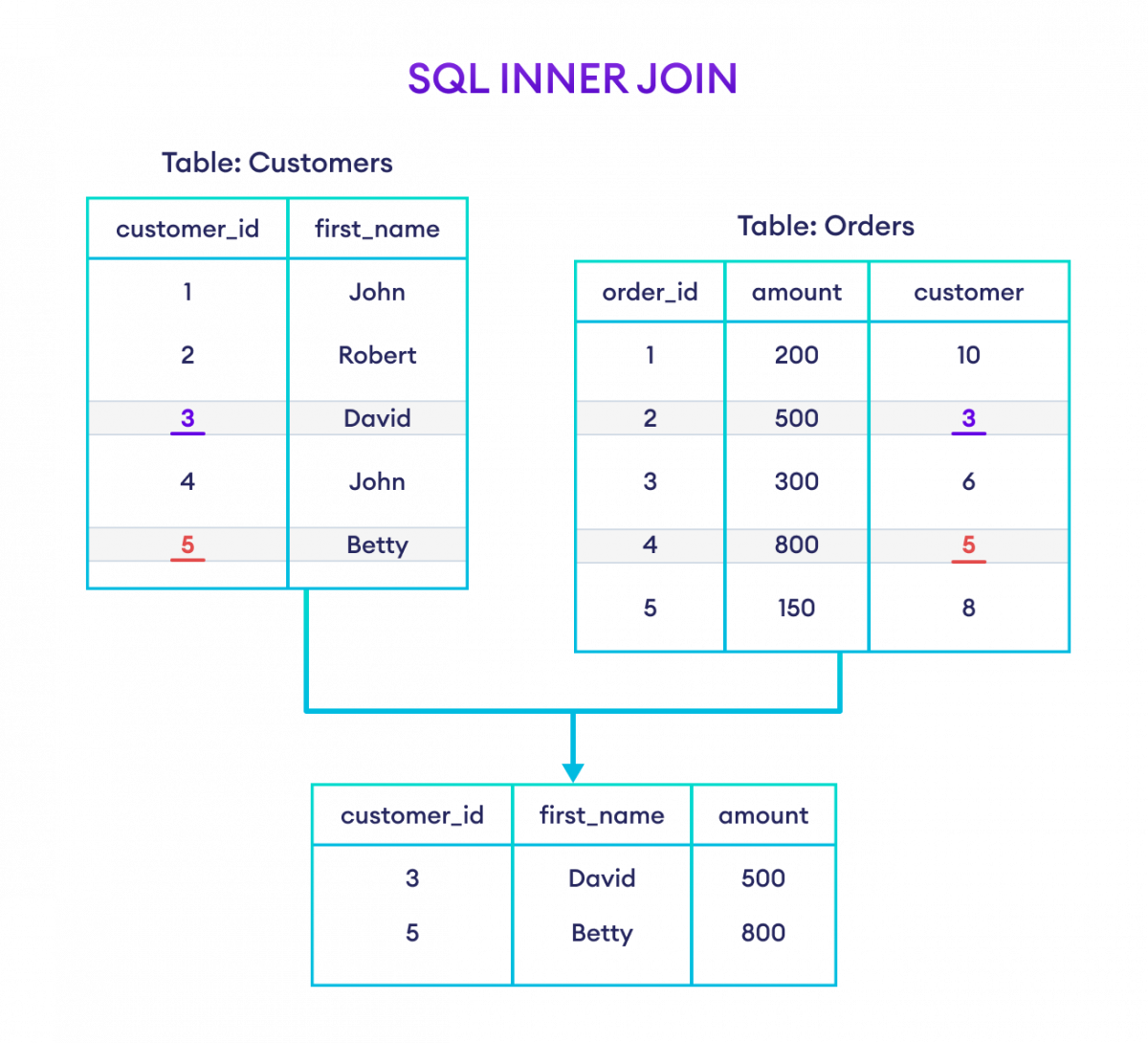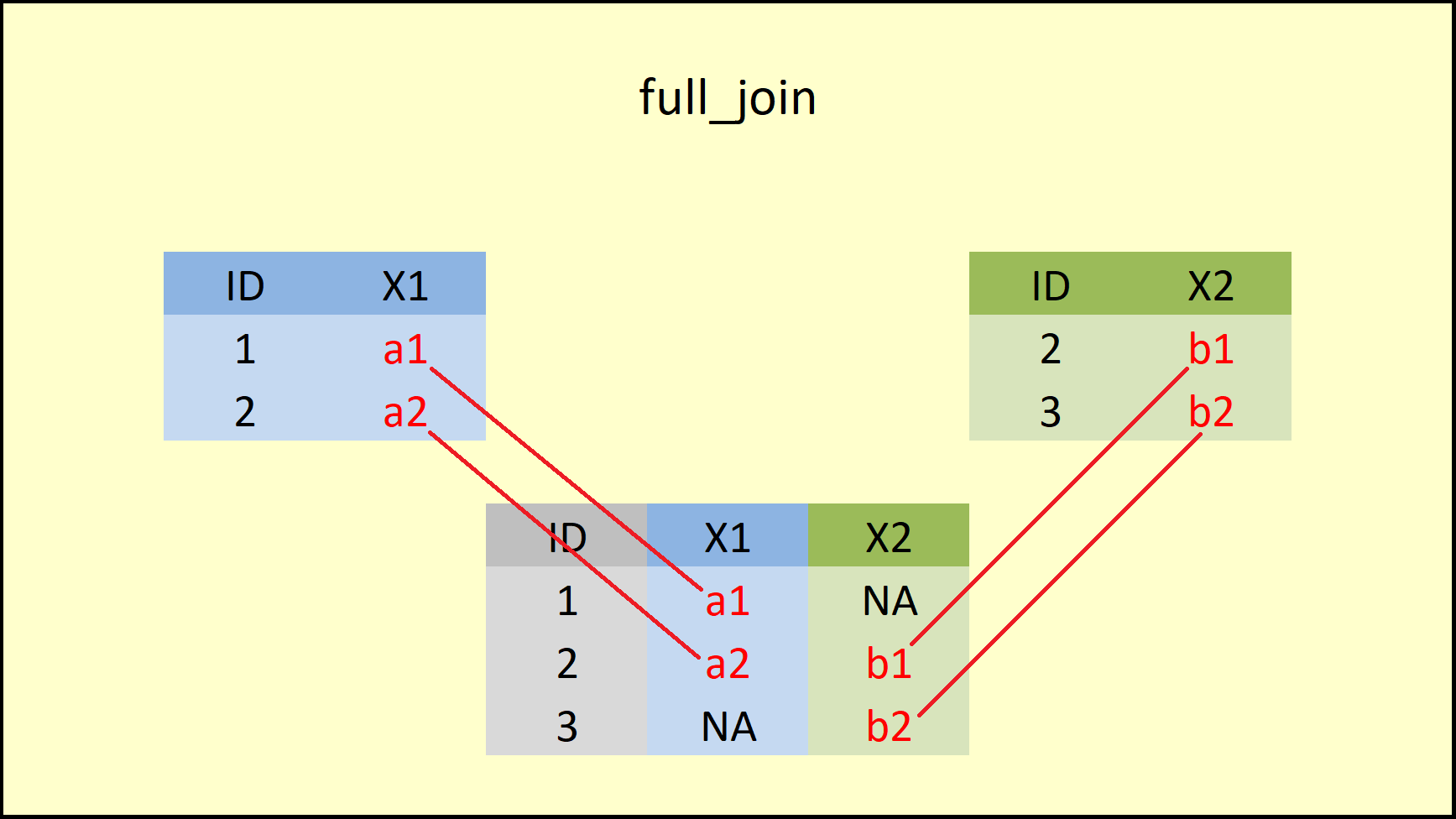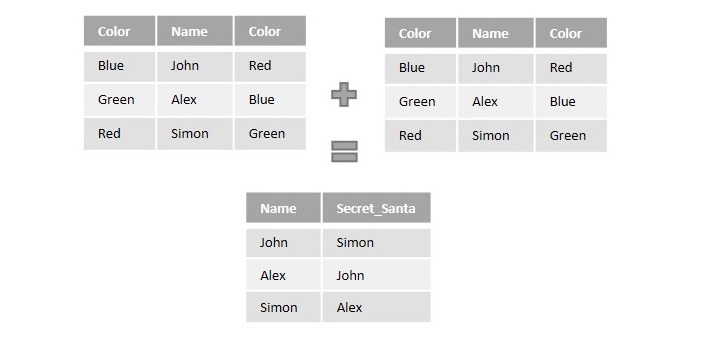Table of Contents
- Data Manipulation Language (DML) - SELECT, INSERT, UPDATE, DELETE
- Data Definition Language (DDL) - CREATE, ALTER, DROP, TRUNCATE
- Data Control Language (DCL) - GRANT, REVOKE, DENY
- Query Clauses - WHERE, ORDER BY, GROUP BY, HAVING, LIMIT
- Querying Data - SELECT, FROM, DISTINCT, AS
- Joins - INNER JOIN, LEFT JOIN, RIGHT JOIN, FULL JOIN, CROSS JOIN
- Subqueries - IN, EXISTS, NOT EXISTS, ANY, ALL
- Aggregate Functions - COUNT, SUM, AVG, MIN, MAX, GROUP_CONCAT
- String Functions - CONCAT, SUBSTRING, LENGTH, UPPER, LOWER, TRIM
- Date and Time Functions - NOW, CURDATE, DATEDIFF, DATE_FORMAT, YEAR, MONTH, DAY
- Conditional Expressions - CASE, IF, ISNULL, COALESCE, NULLIF
- Set Operations - UNION, UNION ALL, INTERSECT, EXCEPT
- Transaction Control - BEGIN, COMMIT, ROLLBACK, SAVEPOINT

Data Manipulation Language (DML) Commands
SELECT
Retrieves data from a database.
Syntax:
SELECT column1, column2 FROM table_name;
Example:
SELECT first_name, last_name FROM customers;
INSERT
Adds new records to a table.
Syntax:
INSERT INTO table_name (column1, column2) VALUES (value1, value2);
Example:
INSERT INTO customers (first_name, last_name)
VALUES ('Mary', 'Doe');
UPDATE
Modifies existing records in a table.
Syntax:
UPDATE table_name SET column1 = value1, column2 = value2 WHERE condition;
Example:
UPDATE employees SET employee_name = 'John Doe', department = 'Marketing' WHERE employee_id = 1;
DELETE
Removes records from a table.
Syntax:
DELETE FROM table_name WHERE condition;
Example:
DELETE FROM employees WHERE employee_name = 'John Doe';
Data Definition Language (DDL) Commands
CREATE
Creates a new database and objects, such as a table, index,
view, or stored procedure.
Syntax:
CREATE TABLE table_name (
column1 datatype1,
column2 datatype2,
...
);
Example:
CREATE TABLE employees (
employee_id INT PRIMARY KEY,
first_name VARCHAR(50),
last_name VARCHAR(50),
age INT
);
ALTER
Adds, deletes, or modifies columns in an existing table.
Syntax:
ALTER TABLE table_name ADD column_name datatype;
Example:
ALTER TABLE customers ADD email VARCHAR(100);
DROP
Drops an existing table in a database.
Syntax:
DROP TABLE table_name;
Example:
DROP TABLE customers;
TRUNCATE
Deletes the data inside a table, but not the table itself.
Syntax:
TRUNCATE TABLE table_name;
Example:
TRUNCATE TABLE customers;
Data Control Language (DCL) Commands
GRANT
Gives specific privileges to users or roles.
Syntax:
GRANT SELECT, INSERT ON table_name TO user_name;
Example:
GRANT SELECT, INSERT ON employees TO 'john_doe';
REVOKE
Takes away privileges previously granted to users or roles.
Syntax:
REVOKE SELECT, INSERT ON table_name FROM user_name;
Example:
REVOKE SELECT, INSERT ON employees FROM 'john_doe';
Query Clauses in SQL
DISTINCT
Removes duplicate values from the result set.
Syntax:
SELECT DISTINCT column1 FROM table_name;
Example:
SELECT DISTINCT department FROM employees;
LIMIT
Restricts the number of rows returned by the query (MySQL, PostgreSQL, SQLite).
Syntax:
SELECT * FROM table_name LIMIT 5;
Example:
SELECT name FROM students LIMIT 10;
OFFSET
Skips the first N rows before starting to return rows from the query.
Syntax:
SELECT * FROM table_name LIMIT 5 OFFSET 10;
Example:
SELECT name FROM students LIMIT 10 OFFSET 20;
FETCH FIRST
Limits the number of rows (used in Oracle 12c+, PostgreSQL, DB2).
Syntax:
SELECT * FROM table_name FETCH FIRST 5 ROWS ONLY;
Example:
SELECT name FROM employees FETCH FIRST 3 ROWS ONLY;
ROWNUM
A pseudo column in Oracle that limits rows in the result.
Syntax:
SELECT * FROM employees WHERE ROWNUM <= 5;
Example:
SELECT name FROM employees WHERE ROWNUM <= 3;
Querying Data Commands
WHERE
Filters rows based on a specified condition.
Syntax:
SELECT * FROM table_name WHERE condition;
Example:
SELECT * FROM customers WHERE age > 30;
ORDER BY
Sorts the result set in ascending or descending order.
Syntax:
SELECT * FROM table_name ORDER BY column_name ASC|DESC;
Example:
SELECT * FROM products ORDER BY price DESC;
GROUP BY
Groups rows based on values in a specified column. Often used
with aggregate functions.
Syntax:
SELECT column_name, COUNT(*) FROM table_name GROUP BY column_name;
Example:
SELECT category, COUNT(*) FROM products GROUP BY category;
HAVING
Filters grouped results based on a specified condition.
Syntax:
SELECT column_name, COUNT(*) FROM table_name GROUP BY column_name HAVING condition;
Example:
SELECT category, COUNT(*) FROM products GROUP BY category HAVING COUNT(*) > 5;
Joining Commands

INNER JOIN
Returns rows with matching values in both tables.

Syntax:
SELECT * FROM table1 INNER JOIN table2 ON table1.column = table2.column;
Example:
SELECT * FROM customers INNER JOIN orders ON customers.customers.id = orders.customer;
LEFT JOIN
Returns all rows from the left table and matching rows from the
right table.
Syntax:
SELECT * FROM table1 LEFT JOIN table2 ON table1.column = table2.column;
Example:
SELECT * FROM students LEFT JOIN departments ON students.students.id = departments.student_id;
RIGHT JOIN
Returns all rows from the right table and matching rows from
the left table.
Syntax:
SELECT * FROM table1 RIGHT JOIN table2 ON table1.column = table2.column;
Example:
SELECT * FROM students RIGHT JOIN departments ON students.students.id = departments.student_id;
FULL JOIN
Returns all rows when there is a match in either the left or
right table.

Syntax:
SELECT * FROM table1 FULL JOIN table2 ON table1.column = table2.column;
Example:
SELECT * FROM employees FULL JOIN departments ON employees.employee_id = departments.employee_id;
CROSS JOIN
Combines every row from the first table with every row from the
second table.

Syntax:
SELECT * FROM table1 CROSS JOIN table2;
Example:
SELECT * FROM employees CROSS JOIN departments;
SELF JOIN
A SELF JOIN is a regular join but the table is joined with itself. It is used to compare
rows within the same table.

Syntax:
SELECT A.column_name, B.column_name
FROM table_name A
JOIN table_name B ON A.common_column = B.common_column;
Example:
SELECT E1.Name AS Employee, E2.Name AS Manager
FROM Employees E1
JOIN Employees E2 ON E1.Manager_ID = E2.Employee_ID;
Subqueries in SQL
IN
Determines whether a value matches any value in a subquery
result.
Syntax:
SELECT column(s) FROM table WHERE value IN (subquery);
Example:
SELECT * FROM customers WHERE city IN (SELECT city FROM suppliers);
ANY
Compares a value to any value returned by a subquery.
Syntax:
SELECT column(s) FROM table WHERE value < ANY (subquery);
Example:
SELECT * FROM products WHERE price < ANY (SELECT unit_price FROM supplier_products);
ALL
Compares a value to all values returned by a subquery.
Syntax:
SELECT column(s) FROM table WHERE value > ALL (subquery);
Example:
SELECT * FROM orders WHERE order_amount > ALL (SELECT total_amount FROM previous_orders);
Aggregate Functions
COUNT()
Counts the number of rows or non-null values in a specified
column.
Syntax:
SELECT COUNT(column_name) FROM table_name;
Example:
SELECT COUNT(age) FROM employees;
SUM()
Calculates the sum of all values in a specified column.
Syntax:
SELECT SUM(column_name) FROM table_name;
Example:
SELECT SUM(revenue) FROM sales;
AVG()
Calculates the average (mean) of all values in a specified
column.
Syntax:
SELECT AVG(column_name) FROM table_name;
Example:
SELECT AVG(price) FROM products;
MIN()
Returns the minimum (lowest) value in a specified column.
Syntax:
SELECT MIN(column_name) FROM table_name;
Example:
SELECT MIN(price) FROM products;
MAX()
Returns the maximum (highest) value in a specified column.
Syntax:
SELECT MAX(column_name) FROM table_name;
Example:
SELECT MAX(price) FROM products;
String Functions
CONCAT()
Concatenates two or more strings into a single string.
Syntax:
SELECT CONCAT(string1, string2, ...) AS concatenated_string FROM table_name;
Example:
SELECT CONCAT(first_name, ' ', last_name) AS full_name FROM employees;
SUBSTRING()/SUBSTR()
Extracts a substring from a string.
Syntax:
SELECT SUBSTRING(string FROM start_position [FOR length]) AS substring FROM table_name;
Example:
SELECT SUBSTRING(product_name FROM 1 FOR 5) AS substring FROM products;
CHAR_LENGTH()/LENGTH()
Returns the length (number of characters) of a string.
Syntax:
SELECT CHAR_LENGTH(string) AS length FROM table_name;
Example:
SELECT CHAR_LENGTH(product_name) AS length FROM products;
UPPER()
Converts all characters in a string to uppercase.
Syntax:
SELECT UPPER(string) AS uppercase_string FROM table_name;
Example:
SELECT UPPER(first_name) AS uppercase_first_name FROM employees;
LOWER()
Converts all characters in a string to lowercase.
Syntax:
SELECT LOWER(string) AS lowercase_string FROM table_name;
Example:
SELECT LOWER(last_name) AS lowercase_last_name FROM employees;
TRIM()
Removes specified prefixes or suffixes (or whitespace by
default) from a string.
Syntax:
SELECT TRIM([LEADING | TRAILING | BOTH] characters FROM string) AS trimmed_string FROM table_name;
Example:
SELECT TRIM(TRAILING ' ' FROM full_name) AS trimmed_full_name FROM customers;
LEFT()
Returns a specified number of characters from the left of a
string.
Syntax:
SELECT LEFT(string, num_characters) AS left_string FROM table_name;
Example:
SELECT LEFT(product_name, 5) AS left_product_name FROM products;
RIGHT()
Returns a specified number of characters from the right of a
string.
Syntax:
SELECT RIGHT(string, num_characters) AS right_string FROM table_name;
Example:
SELECT RIGHT(order_number, 4) AS right_order_number FROM orders;
REPLACE()
Replaces occurrences of a substring within a string.
Syntax:
SELECT REPLACE(string, old_substring, new_substring) AS replaced_string FROM table_name;
Example:
SELECT REPLACE(description, 'old_string', 'new_string') AS replaced_description FROM product_descriptions;
Date and Time Functions
CURRENT_DATE()
Returns the current date.
Syntax:
SELECT CURRENT_DATE() AS current_date;
CURRENT_TIME()
Returns the current time.
Syntax:
SELECT CURRENT_TIME() AS current_time;
CURRENT_TIMESTAMP()
Returns the current date and time.
Syntax:
SELECT CURRENT_TIMESTAMP() AS current_timestamp;
Extract Year and Month from a Date
In MySQL, you can extract the year and month separately using
YEAR() and
MONTH(),
or combine them using DATE_FORMAT().
Syntax:
-- Separate year and month
SELECT YEAR(date_column) AS year_part, MONTH(date_column) AS month_part;
-- Combined year and month (e.g., '2024-07')
SELECT DATE_FORMAT(date_column, '%Y-%m') AS year_month;
Example:
SELECT YEAR('2024-07-12') AS year_part, MONTH('2024-07-12') AS month_part;
SELECT DATE_FORMAT('2024-07-12', '%Y-%m') AS year_month;
DATE_ADD()/DATE_SUB()
Adds or subtracts a specified number of days, months, or years
to/from a date.
Syntax:
SELECT DATE_ADD(date_expression, INTERVAL value unit) AS new_date;
DATE_ADD Example:
SELECT DATE_ADD('2024-04-11', INTERVAL 1 DAY) AS new_date;
DATE_SUB Example:
SELECT DATE_SUB('2024-04-11', INTERVAL 1 DAY) AS new_date;
EXTRACT()
Extracts a specific part (e.g., year, month, day) from a date
or time.
Syntax:
SELECT EXTRACT(part FROM date_expression) AS extracted_part;
Example:
SELECT EXTRACT(YEAR FROM '2024-04-11') AS extracted_part;
TO_CHAR()
Converts a date or time to a specified format.
Syntax:
SELECT TO_CHAR(date_expression, 'format') AS formatted_date;
Example:
SELECT TO_CHAR('2024-04-11', 'YYYY-MM-DD') AS formatted_date;
TIMESTAMPDIFF()
Calculates the difference between two timestamps in a specified
unit (e.g., days, hours, minutes).
Syntax:
SELECT TIMESTAMPDIFF(unit, timestamp1, timestamp2) AS difference;
Example:
SELECT TIMESTAMPDIFF(DAY, '2024-04-10', '2024-04-11') AS difference;
DATEDIFF()
Calculates the difference in days between two dates.
Syntax:
SELECT DATEDIFF(date1, date2) AS difference_in_days;
Example:
SELECT DATEDIFF('2024-04-11', '2024-04-10') AS difference_in_days;
Conditional Expressions
CASE Statement
Allows you to perform conditional logic within a query.
Syntax:
SELECT
column1,
column2,
CASE
WHEN condition1 THEN result1
WHEN condition2 THEN result2
ELSE default_result
END AS alias
FROM table_name;
Example:
SELECT
order_id,
total_amount,
CASE
WHEN total_amount > 1000 THEN 'High Value Order'
WHEN total_amount > 500 THEN 'Medium Value Order'
ELSE 'Low Value Order'
END AS order_status
FROM orders;
IF() Function
Evaluates a condition and returns a value based on the
evaluation.
Syntax:
SELECT IF(condition, true_value, false_value) AS alias FROM table_name;
Example:
SELECT
name,
age,
IF(age > 50, 'Senior', 'Junior') AS employee_category
FROM employees;
COALESCE() Function
Returns the first non-null value from a list of values.
Syntax:
SELECT COALESCE(value1, value2, ...) AS alias FROM table_name;
Example:
SELECT
COALESCE(first_name, middle_name) AS preferred_name
FROM employees;
NULLIF() Function
Returns null if two specified expressions are equal.
Syntax:
SELECT NULLIF(expression1, expression2) AS alias FROM table_name;
Example:
SELECT
NULLIF(total_amount, discounted_amount) AS diff_amount
FROM orders;
Set Operations
UNION
Combines the result sets of two or more SELECT statements into
a single result set.
Syntax:
SELECT column1, column2 FROM table1 UNION SELECT column1, column2 FROM table2;
Example:
SELECT first_name, last_name FROM customers UNION SELECT first_name, last_name FROM employees;
INTERSECT
Returns the common rows that appear in both result sets.
Syntax:
SELECT column1, column2 FROM table1 INTERSECT SELECT column1, column2 FROM table2;
Example:
SELECT first_name, last_name FROM customers INTERSECT SELECT first_name, last_name FROM employees;
EXCEPT
Returns the distinct rows from the left result set that are not
present in the right result set.
Syntax:
SELECT column1, column2 FROM table1 EXCEPT SELECT column1, column2 FROM table2;
Example:
SELECT first_name, last_name FROM customers EXCEPT SELECT first_name, last_name FROM employees;
Transaction Control Commands
COMMIT
Saves all the changes made during the current transaction and
makes them permanent.
Syntax:
COMMIT;
Example:
BEGIN TRANSACTION;
INSERT INTO employees (name, age) VALUES ('Alice', 30);
UPDATE products SET price = 25.00 WHERE category = 'Electronics';
COMMIT;
ROLLBACK
Undoes all the changes made during the current transaction and
discards them.
Syntax:
ROLLBACK;
Example:
BEGIN TRANSACTION;
INSERT INTO employees (name, age) VALUES ('Bob', 35);
UPDATE products SET price = 30.00 WHERE category = 'Electronics';
ROLLBACK;
SAVEPOINT
Sets a point within a transaction to which you can later roll
back.
Syntax:
SAVEPOINT savepoint_name;
Example:
BEGIN TRANSACTION;
INSERT INTO employees (name, age) VALUES ('Carol', 28);
SAVEPOINT before_update;
UPDATE products SET price = 40.00 WHERE category = 'Electronics';
SAVEPOINT after_update;
DELETE FROM customers WHERE age > 60;
ROLLBACK TO before_update;
COMMIT;
ROLLBACK TO SAVEPOINT
Rolls back to a specific savepoint within a transaction.
Syntax:
ROLLBACK TO SAVEPOINT savepoint_name;
Example:
BEGIN TRANSACTION;
INSERT INTO employees (name, age) VALUES ('David', 42);
SAVEPOINT before_update;
UPDATE products SET price = 50.00 WHERE category = 'Electronics';
SAVEPOINT after_update;
DELETE FROM customers WHERE age > 60;
ROLLBACK TO SAVEPOINT before_update;
COMMIT;
SET TRANSACTION
Configures properties for the current transaction, such as
isolation level and transaction mode.
Syntax:
SET TRANSACTION [ISOLATION LEVEL { READ COMMITTED | SERIALIZABLE }]
Example:
BEGIN TRANSACTION;
SET TRANSACTION ISOLATION LEVEL READ COMMITTED;
INSERT INTO employees (name, age) VALUES ('Emily', 35);
UPDATE products SET price = 60.00 WHERE category = 'Electronics';
COMMIT;